- Otterbein UMC Carlisle
History - Civil War Veterans in Springville Cemetery
- Pastors Who Have Served at Otterbein
Otterbein UMC history
To understand the history of our church it is helpful to put ourselves in the perspective of those that settled in the area in the 1700s, as described below in a paper that was provided by Mrs. Patricia (“Pat”) W. Strickler:
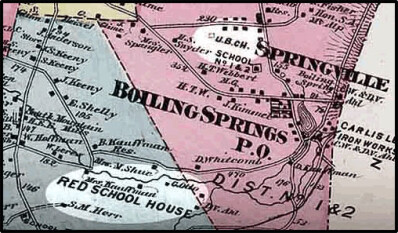
Source: 1872 Atlas of Cumberland County
The news of great opportunities and privileges offered by the New World reached the oppressed inhabitants of Germany, and they came by the thousands to our shores....
Many of the immigrants brought with them their catechisms, hymn books, Bibles, and other devotional materials. They formed congregations and schools; if no minister was available, they would encourage each other by singing and listening to sermons and prayers read by their pious schoolmasters. A schoolmaster was considered closely akin to the minister during this time. Many log or stone buildings were erected to serve the dual purpose of schoolhouse and church.
This is evident in looking at the earliest meeting places that later became the church that we know today as Otterbein United Methodist Church. However, prior to speaking of the “Red School House” and the “Wise School House” it would be helpful to know about the man Philip W. Otterbein — a young minister from Germany.
Sailing to New York in 1752, Philip Otterbein came to America as a missionary to the German Reformed immigrants in Pennsylvania. After being assigned to the Reformed Church in Lancaster he later served as pastor of the German Reformed Church in Frederick, Maryland; York, Pennsylvania; and in Baltimore, Maryland.
In 1765 while attending “a Big Meeting” (revival) held in the Isaac Long barn near Lancaster he was inspired by a Mennonite reverend — Martin Boehm. This marked the beginning of a lasting friendship.
In 1789 Philip Otterbein and Martin Boehm, along with several others, held a conference that resulted in the founding of what would be called the United Brethren in Christ Church. In 1800 Philip Otterbein and Martin Boehm were elected as the first bishops of this new “American born” denomination.
The home of John Shopp, Sr., located close to Shiremanstown, was an early “preaching place” which served as a central location to a system that consisted of traveling the circuit for pastoral visitation, evangelical, and ministerial work.
The homes of Reverend Abraham Mayer, four miles west of Carlisle, and that of Reverend Abraham Hershe, a few miles east of Carlisle, also served as preaching places in the valley.
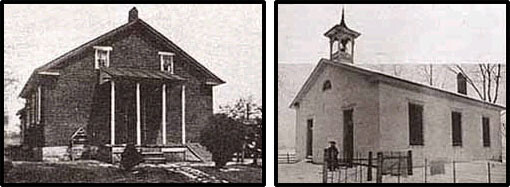
Source: History of South Middleton Township
At the 1843 Pennsylvania Conference, held in Franklin County, Reverend J. S. Kessler was assigned to the new Hershe Station which was set apart from the Carlisle Circuit. Through the efforts of Reverend Kessler, Boiling Springs became part of the “Hershe Circuit.” Two meeting places near Boiling Springs, which were served by itinerant preachers as they passed on their way to Shopp’s Church in Shiremanstown, were to become part of this Hershe Circuit — marking the beginning of the Otterbein Church of today. In 1843, at the home of John Jacob Wise, followers organized a “class” (church) and after outgrowing the home they started meeting at the Wise School House two miles northwest of Boiling Springs. This served as a place of worship until 1855 when, during the pastorate of Reverend G. W. Showman, services were moved to Springville where a church was built. The Springville Cemetery occupies the site where the Springville Church once stood.
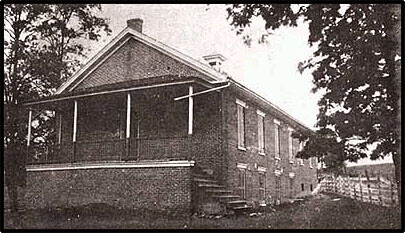
Source: History of South Middleton Township.
The second group had its start on the farm of Christian Herr who came to Cumberland County in 1834. He set aside a portion of ground on his farm and built a church and school house. In 1870 the log cabin building was replaced with a red brick building and was known as the Paradise Appointment, commonly referred to as the Red School House, and was located on the southwest corner of Creek Road and Petersburg Road. Church services were held in the basement and the upper floor served as a school. This church was known for its singing. In 1886 when Reverend A. R. Ayres came as pastor to the church he found the members sitting according to the parts they sang rather than as families. In 1897, during the pastorate of Reverend S. N. Moyer, the congregations at Paradise and Springville united and with neither building being large enough for their combined congregations, a new church was built in Boiling Springs. Two stained glass windows at this new church recognized the Paradise and Springville Young People’s Christian Unions who purchased the property at a cost of $440. The new church in Boiling Springs was built at a cost of $8,600 (including the property).
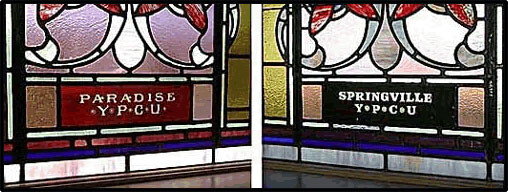
On November 16, 1946, the United Brethren in Christ Church and the Evangelical Church merged to form the Evangelical United Brethren Church.
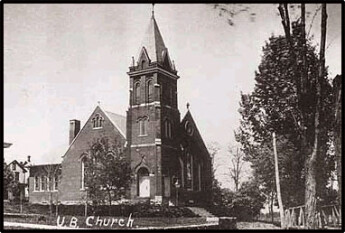
Source: Otterbein UM Church 1993 Directory.
On April 23, 1968, the Evangelical United Brethren Church and the Methodist Church adopted a plan of union. Wanting to keep our heritage in our name we became the Otterbein United Methodist Church. Many improvements had been made to the church in Boiling Springs. In 1918 electric lights were installed and the north wall repaired. In 1938 the basement, heating plant, and kitchen were completed. Extensive renovations were started in 1949 which included complete re-plastering, refinishing of pews, new carpet, redesigned chancel area, a new Baldwin electric organ, installation of a sound system, and the remodeling of the church parsonage. In 1961 ground was broken and the cornerstone laid for the new educational wing. Major renovations to the sanctuary were completed during 1977-78: the stained glass windows were re-leaded and protected from the weather, new carpet was laid, and oak pews were installed. Much of the information that was provided for this “History of Otterbein United Methodist Church” was provided by the previously mentioned paper supplied by Mrs. Pat Strickler in 1993, which marked the 150th anniversary of our congregation: Writing this paper was like opening my hope chest ... The lovely tatted dollie was made for me as a young girl by Jessie Hoener. Jessie and her sister, Lena Mae, served as missionaries in Sierra Leone from this church. A sampler made in Springville by my great, great grandmother in 1856, the pretty dish given to my great grandmother by her Sunday School class, the baton my grandfather used to direct the church orchestra and choir for 40 years, the picture of my father with his trumpet — he played many solo’s in this church, the wonderful memories of the beautiful music provided by my mother, who served so faithfully as church organist for over twenty-five years, the pleasure of being married in this church, the privilege of having my sons baptized and confirmed at this alter, and the joy of seeing my mother’s five grandchildren sing in her honor when she was buried from this church. A constant reminder of my heritage is the beautiful stained glass window ... honoring Jacob and Sophia Wise, my great, great grandparents.
In 1997 we celebrated 154 years as a congregation, and the building that was our place of worship had reached an age of 100 years. This also represented a time when, once again, the size of our congregation outgrew that of the building. On June 15, 1997, ground was broken for a beautiful new worship facility along Forge Road.
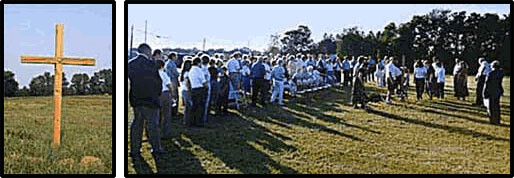
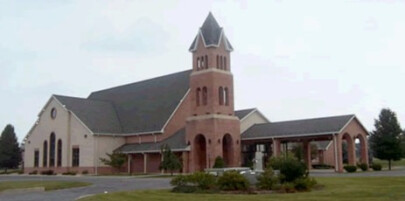
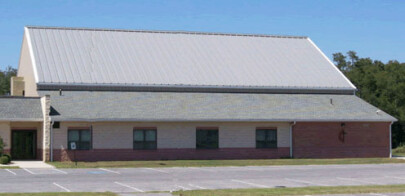
We commemorated the one hundred and sixtieth anniversary of the battle of Gettysburg on July 2, 2023, and also honored the twenty-eight Civil War Veterans from our community buried in Springville Cemetery, Boiling Springs, PA.
A list of these of these veterans was been compiled with details of their service.
May this small recitation of their military service remind us of the great sacrifices endured by the many, so that the nation might live.
Civil War Veterans
Buried In
Springville Cemetery
Boiling Springs, PA
As we commemorate the one hundred and sixtieth anniversary of the battle of Gettysburg on July 2, 2023, we also honor the twenty-eight Civil War Veterans from our community buried in Springville Cemetery. May this small recitation of their military service remind us of the great sacrifices endured by the many, so that the nation might live.
Private John S. Baker was mustered into Company A, 209th Regiment of Pennsylvania Volunteer Infantry on September 6, 1864. After organizing at Camp Curtin, the Regiment was sent to the Army of the James and later the Army of the Potomac in Virginia. They saw combat along the James River and in the Petersburg and Richmond Campaigns. Private Baker was mustered out with his company on May 31, 1865.
Private William Barbour Jr. enlisted in Company I, 46th Regiment of Indiana Volunteer Infantry on January 27, 1864, in Wabash County, Indiana. He was detached for service with Varners Battalion, a unit composed of non-veterans from the 5th Indiana and later attached to the 56th Ohio Volunteer Infantry in the Department of the Gulf on March 2, 1864. On June 4, 1865, he was admitted to Nelson U.S. Army Hospital in Lexington, Kentucky. As the war had ended, he was charged three times for transportation to the Hospital: $19.26, $7.48, and $1.48, respectively. Private Barbour was mustered out on September 4, 1865.
Private Jacob Bricker was mustered into Company A, 158th Regiment of Pennsylvania Volunteer Infantry at Chambersburg in November 1862. The Regiment was ordered to the front in Virginia and in December went into winter encampment in New Bern, NC. From this location, it participated in numerous expeditions and engagements until it was ordered to Fort Monroe, VA on June 11, 1863. Before he could join the move, Private Bricker died of disease at Washington, NC on July 8, 1863.
Private Christian M. Burn was mustered into Company A, 209th Regiment of Pennsylvania Volunteer Infantry on September 6, 1864. After organizing at Camp Curtin, the Regiment was sent to the Army of the James and later the Army of the Potomac in Virginia. They saw combat along the James River and in the Petersburg and Richmond Campaigns. Private Burn was mustered out with his company on May 31, 1865.
Private J. William Calaman was mustered into Company H, 13th Regiment of Pennsylvania Volunteer Cavalry on August 28, 1863. His Regiment saw combat at the Wilderness, Spotsylvania Court House, and Cold Harbor, VA, Wilmington and Raleigh, NC, and the surrender of Confederate General Johnston to General Sherman. He was mustered out with his unit on July 14, 1865.
Private David Z. Cornman enlisted in Company E, 87th Regiment of Pennsylvania Volunteer Infantry on September 4, 1861, in York. A spent bullet struck him in the right foot on the retreat from the battle of Carters Woods, near Winchester, VA on June 15, 1863. In January 1864, he reenlisted, rejoined his unit and was court martialed for writing passes for his friends while on guard duty. He was wounded again by a shot through his left wrist at the battle of Cold Harbor on June 3, 1864. On March 14, 1865, Private Cornman was transferred to the Veteran Reserve Corps and honorably discharged by General Order on July 20, 1865.
Private James H. Dasher served in three distinct units during the War. On April 22, 1861, he mustered into Company G, 10th Regiment of Pennsylvania Volunteer Infantry and mustered out with the Regiment on July 31, 1861. He then mustered into Company E, 125th Regiment of Pennsylvania Volunteer Infantry, on August 13,1862 and mustered out on May 18, 1863. Finally, he mustered into Company A, 55th Regiment of Pennsylvania Volunteer Infantry on February 23, 1864. On May 16, 1864, he was captured during the battle of Proctors Creek, near Petersburg, VA. and was transported to the notorious Confederate Prison Camp at Andersonville, GA. Private Dasher remained there until April 29, 1865. On May 20, 1865, he was discharged from the Army.
Private James P. Dougherty enlisted in Company H, 1st Pennsylvania Reserve Corps on June 8, 1861. His Regiment fought at the Seven Days Battle, Antietam, Fredericksburg, Gettysburg, Rapidan and Spotsylvania. He was mustered out with his unit on June 13, 1864.
Private James A. Fellers enlisted in Company I, 87th Regiment of Pennsylvania Volunteer Infantry on September 5, 1861, but was later transferred to Company B. In June 1863, he was wounded at the battle of Winchester, VA. and endured two amputations on his left leg. The first took his leg below the knee while the second took the leg above his knee. He was discharged by Surgeons Certificate on May 20, 1865. With good reason he was listed as absent, and sick, when his Regiment mustered out.
Private Edward Giles enlisted in Company D, 1st Maryland Potomac Home Brigade Infantry on September 6, 1861, in Frederick. He went absent without leave in May 1862 but returned and was captured with his unit at Harpers Ferry on September 15, 1862. His Brigade was exchanged in southern Maryland in June 1863. He re-enlisted as a veteran volunteer on January 19,1864 in the 13th Regiment of Maryland Volunteer Infantry and was mustered out with that unit on May 29, 1865. His units saw combat at Winchester, VA; Harpers Ferry, VA; Loudon Heights, VA; Gettysburg, the pursuit of Lee after Gettysburg, Monocacy, MD; and Confederate General Early’s invasion of Maryland and Pennsylvania in 1864. Private Giles was mustered out with his unit on May 29, 1865.
Private Isaac H. Kaufman was mustered into Company F, 1st Regiment of Pennsylvania Volunteer Infantry on September 11,1862 in Mechanicsburg. He deserted on September 20,1862.
Private Emanuel Lackey was mustered into Company A, 209th Regiment of Pennsylvania Volunteer Infantry on September 6, 1864. After organizing at Camp Curtin, the Regiment was sent to the Army of the James and later the Army of the Potomac in Virginia. They saw combat along the James River and in the Petersburg and Richmond Campaigns. Private Lackey was mustered out with his company on May 31, 1865.
Private Levi Lackey was mustered into Company A, 209th Regiment of Pennsylvania Volunteer Infantry on September 8, 1864. After organizing at Camp Curtin, the Regiment was sent to the Army of the James and later the Army of the Potomac in Virginia. Private Lackey was wounded at Bermuda Hundred, VA, on November 17, 1864, losing his leg. He was discharged by Surgeons Certificate on April 11, 1865.
Private Peter Leer mustered into Company H, 87th Regiment of Pennsylvania Volunteer Infantry on September 19, 1861, in York. He fell ill in February 1862, suffering from successive attacks of measles, erysipelas, and typhoid fever. On April 1, 1863, he was discharged by Surgeons Certificate. He recovered and reenlisted in Company A, 103rd Regiment of Pennsylvania Volunteer Infantry on March 6, 1865. Subsequently, Leer was promoted to Sergeant on March 17, 1865, and mustered out with his unit on June 25, 1865. During his service with the 87th Regiment, Private Leer was involved in guarding railroad lines in the Middle Department of Pennsylvania. When he joined the 103rd Regiment, it was being reconstituted with eight new companies after great losses in soldiers due to casualties and prisoners. These eight reconstituted companies reached New Bern, NC and were mustered out there on June 25, 1865.
Private James N. Nickel mustered into Company C, 19th Regiment of Pennsylvania Volunteer Cavalry on July 7, 1863. On February 5, 1865, he was promoted to Corporal. His service was in the western campaigns including the battles of Nashville and Franklin, TN. Corporal Nickel ended his service on Provost Marshal duty in New Orleans from June 1865 until being mustered out on May 14, 1866.
Private George W. Riggleman enlisted in Company H, 133rd Regiment of Pennsylvania Volunteer Infantry on August 13, 1862, and mustered out with his Company on May 25, 1863. During his term of service, the Regiment saw combat at Antietam, Fredericksburg, and Chancellorsville.
Private William Shupp mustered into Company M, 22nd Regiment of Pennsylvania Volunteer Cavalry on February 23, 1864. He later transferred to Company M, 3rd Regiment of Pennsylvania Volunteer Cavalry. On June 24, 1865, his Regiment was consolidated with the 18th Regiment of Pennsylvania Volunteer Cavalry to create the 3rd Regiment of Pennsylvania Volunteer Provisional Cavalry. On October 31, 1865, Private Shupp mustered out with his unit. During his time of service, he saw combat in the Shenandoah Valley, most notably with General Sheridan’s Shenandoah Valley campaign, the battle of Winchester, Opequan and Cedar Creek.
Private John D. Spidle mustered into Company B, 165th Regiment of Pennsylvania Volunteer Infantry on November 4, 1862. During this enlistment, he was engaged in combat in Virginia as part of General Dix’s Peninsula campaign. On July 28, 1863, he mustered out with his unit. On March 9, 1864, he enlisted into Battery L, 2nd Pennsylvania Heavy Artillery, in Carlisle. During this term of service, he served in the garrison protecting Washington, DC, the battles of Cold Harbor, Bermuda Hundred and Petersburg, VA. On August 21, 1865 (four months after General Lee’s surrender), he deserted in Petersburg, VA.
Private Joseph Swords mustered into Company G, 84th Regiment of Pennsylvania Volunteer Infantry on October 2, 1862. He participated in the battle of Fredericksburg, VA in December 1862 and was captured at the battle of Chancellorsville, VA on May 3, 1863. Upon his release on January 13, 1865, he was assigned to Company K, 57th Regiment of Pennsylvania Volunteer Infantry and participated in the actions at Petersburg, Sailors Creek, and Appomattox Court House, VA. During muster out on June 29, 1865, he was listed as absent and sick.
Private Henry Titler enlisted in Battery B, Pennsylvania Light Artillery in Chambersburg, on September 1, 1861. He served in the western campaigns of the war and participated in the battles of Shiloh, TN; Perryville, KY; Stone’s River, TN; Chickamauga, GA; Chattanooga, TN; Atlanta, GA; Nashville and Franklin, TN. On October 12, 1865, he mustered out in Victoria, TX.
Private Cornelius B. Troup attempted to enlist twice while underage and used different spellings of his last name. He finally gained enlistment in Company B, 130th Regiment of Pennsylvania Volunteer Infantry on August 11, 1862, in Harrisburg. During this initial term of service, he saw combat in the battles of Antietam, MD, Fredericksburg and Chancellorsville, VA. On May 21, 1863, Private Troup was mustered out with his unit. On August 23, 1864, he enlisted with Company I, 12th Regiment of Pennsylvania Volunteer Cavalry. He was captured on November 22, 1864, near Hall Town, WV and incarcerated in the stockade at Salisbury, NC. Paroled at Cox’s Wharf on March 10, 1865, and furloughed home on March 15, he returned to his Regiment on May 10, 1865, after exchange. On June 1, 1865, he was discharged by General Order. Private Troup returned home with impaired hearing that he blamed on his incarceration. His tombstone mistakenly lists Trout as his last name.
Private Philip R. Weirich enlisted in Company G, 28th Regiment of Ohio Volunteer Infantry on June 13, 1861, at Camp Denison, near Cincinnati, OH. The Regiment was known as the Second German Ohio Regiment. On May 4, 1862, he was promoted to Corporal. During his service, Corporal Weirich participated in the battle of South Mountain, MD; Antietam, MD; New Market and Carnifex Ferry, VA. On July 23, 1864, at the expiration of his term of service, he was mustered out with his unit.
Private Jacob E. Witter enlisted in Company F, 13th Regiment of Pennsylvania Volunteer Cavalry on August 23, 1862. He was later promoted to Corporal and then to Sergeant on May 20, 1865. He participated in combat at Cedar Creek, VA; as part of the operations in the Shenandoah Valley and Winchester, VA; the Bristoe campaign, Wilderness, Spotsylvania and Cold Harbor, VA; Wilmington, Fayetteville and Raleigh, NC, and the surrender of Confederate General Johnston. On July 14, 1865, Sergeant Witter mustered out with his Company.
Private Jacob E. Wise (known as Edward J. Wise in all military records) enlisted in Company H, 87th Regiment of Pennsylvania Volunteer Infantry on September 19, 1861, in York. On June 15, 1863, he injured his ankle during a charge at the battle of Carter’s Woods, near Winchester, VA. Due to this injury, he was temporarily assigned to the Army of the Susquehanna as a teamster. During his enlistment, Private Wise participated in combat operations at Winchester, VA; pursuit of Lee from Gettysburg, the Rapidan campaign, battles of Wilderness, Cold Harbor and Petersburg, VA, and Sheridan’s campaign in the Shenandoah Valley. He mustered out with his Company at the expiration of its term of service on October 13, 1864.
Private Alexander Wolfe enlisted in Company C, 9th Regiment of Pennsylvania Volunteer Infantry on April 23, 1861. He participated in the advance to the Potomac and the occupation of Martinsburg and Charlestown, WV. He mustered out with his unit on July 24, 1861.
Private Benjamin F. Wollet was drafted into Company A, 158th Regiment of Pennsylvania Volunteer Infantry on November 1, 1862. In this term of service, he participated in combat operations with the expedition to New Bern, NC, General Dix’s Peninsula Campaign, and the pursuit of General Lee from Gettysburg. On August 12, 1863, he mustered out with his Company. On September 1, 1864, Wollet reenlisted with Company A, 209th Regiment of Pennsylvania Volunteer Infantry and saw action at Petersburg, Fort Stedman, Hatchers Run, the pursuit of General Lee and Nottaway Courthouse, all in Virginia. On May 31, 1865, he mustered out with A Company.
Private John D. Wonderly enlisted in Company D, 21st Regiment of Pennsylvania Volunteer Cavalry on July 15, 1863. He died at Chambersburg in September.
Private Levi Yost was drafted into Company C, 158th Regiment of Pennsylvania Volunteer Infantry at Fort McClure, Chambersburg, on October 16, 1862. He participated in the occupation of Suffolk, VA; the expedition to New Bern, NC; and the expedition of relief of Little Washington, NC. He deserted on June 6, 1863.
Note: Mustered Out: In military organization, the term muster is the process or event of accounting for members in a military unit. This practice of inspections led to the coining of the English idiom pass muster, meaning being sufficient. When a unit is created, it is "mustered in" and when it is disbanded, it is "mustered out".
| J. Kessler and A. Hershe G. Miller Z. A. Colestock G.W. Showman J. Dickson Z. A. Colestock T. S. McNeil G. W. Showman I. C. Weidler Isaac Coomes J. W. Burd and D. Eberly J. W. Burd and H. A. Schlichter J. W. Burd and H. Young J. G. Schaff Jacob Erb J. S Wentz S. Bigham A. Tripner N. Altman H. Brown W. H. Wagner I. C. Weidler J. S. Wentz H. A. Schlichter P. A. Bowman A. R. Ayres J. W Grimm J. O. Clippinger S. N. Moyer J. W. Kiracofe Rudolph Byrd D. M. Oyer J. F. Snyder J. A. Gohn A. C. Crone E. C. B. Castle C. C. Miller J. B. Reed, Jr. R. R. Zeigler J. H. Lehman R. D. Leonard O. H. Walter David L. Reed Neil L. Irons Daniel Dennis Bruce Fensterbush Steve Salisbury |
1843 - 1845 1845 - 1847 1847 - 1848 1848 - 1849 1849 - 1850 1850 - 1852 1852 - 1853 1853 - 1856 1856 - 1857 1857 - 1858 1858 - 1859 1859 - 1860 1860 - 1861 1861 - 1862 1862 - 1863 1863 - 1864 1864 - 1866 1866 - 1868 1868 - 1870 1870 - 1872 1872 - 1875 1875 - 1879 1879 - 1880 1880 - 1884 1884 - 1886 1886 - 1890 1890 - 1892 1892 - 1895 1895 - 1900 1900 - 1904 1904 - 1909 1909 - 1914 1914 - 1925 1925 - 1926 1926 - 1928 1928 - 1933 1933 - 1937 1937 - 1945 1945 - 1952 1952 - 1961 1961 - 1969 1969 - 1982 1982 - 2006 2006 - 2007 2007 - 2018 2018 - 2020 2020 - Present |
